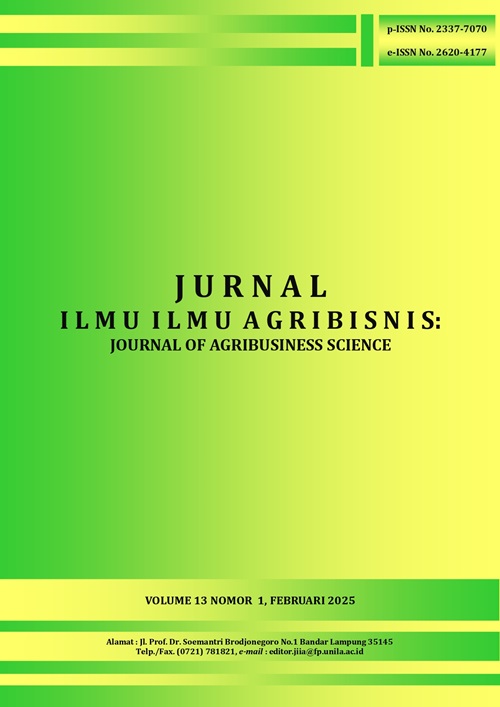ANALISIS DAYA SAING JERUK SIAM DALAM MENDUKUNG PENGEMBANGAN KOMODITAS BUAH UNGGULAN DI BANYUWANGI
DOI:
https://doi.org/10.23960/jiia.v13i1.8220 Abstract View: 348
Abstract View: 348
Abstract
Siamese oranges are a fruit commodity that is quite popular with a consumption growth rate of 2.5% from 2018 to 2022. This condition must be balanced with the availability of local oranges in Indonesia, without increasing orange imports. Orange production in Banyuwangi is quite high in Tegaldlimo District, reaching 201,821.5 tons in 2018, eventhough in 2019 it decreased to 91,991.9 tons. The objectives of this research are to determine the competitiveness of Siamese oranges in Banyuwangi, to determine the sensitivity of the competitiveness of Siamese oranges in Banyuwangi, and to formulate a commodity development model for Siamese oranges in Banyuwangi. The methods used in this research were analysis of private benefits (PP), private cost ratio (PCR), social benefits (SP), and domestic resource ratio (DRCR). Based on the results of the analysis, it is known that the private profit obtained is IDR111,183,814 while the social benefits obtained is IDR362,759,134. The PCR value is 0.67 and the DRCR value is 0.37. It is also noticed that A 25% and 50% reduction in the price of Siamese oranges from the normal price has caused a loss in private profits and caused a PCR value more than 1, whereas in the scenario of a 30% increase in the price of inorganic fertilizer, it has caused a negative value in private profits and a PCR value more than 1. Development of Siamese orange farming in the Regency Banyuwangi is encouraging with combination of strategy intensive agricultural extension and increase production output in terms of quantity, quality and continuity of production.
Keywords: competitiveness, siamese oranges, superior commodities
Downloads
Downloads
Published
How to Cite
Issue
Section
License
Authors who publish with this journal agree to the following terms:
Authors retain copyright and grant the journal right of first publication with the work simultaneously licensed under a Creative Commons Attribution License that allows others to share the work with an acknowledgement of the work's authorship and initial publication in this journal.
Authors are able to enter into separate, additional contractual arrangements for the non-exclusive distribution of the journal's published version of the work (e.g., post it to an institutional repository or publish it in a book), with an acknowledgement of its initial publication in this journal.
Authors are permitted and encouraged to post their work online (e.g., in institutional repositories or on their website) prior to and during the submission process, as it can lead to productive exchanges, as well as earlier and greater citation of published work (See The Effect of Open Access).














